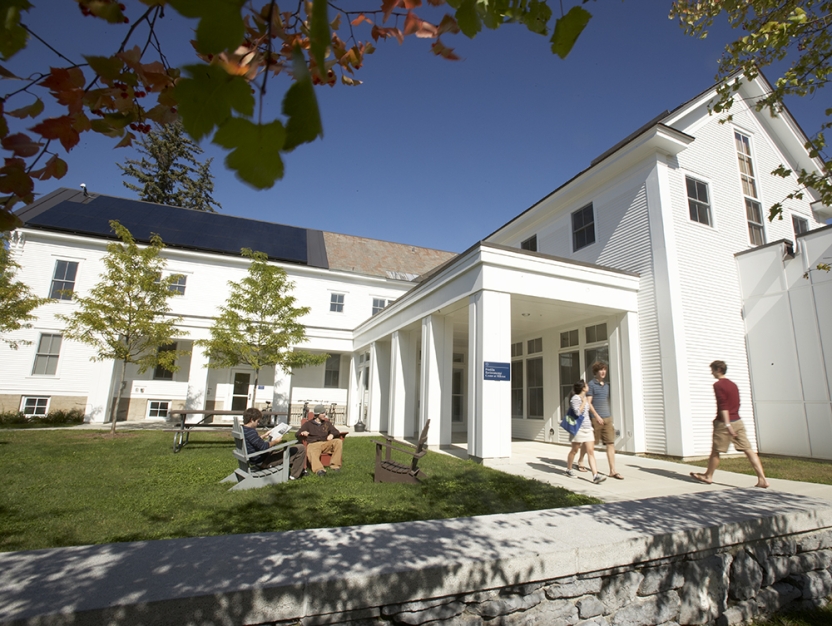ES Faculty Panel Offers Varying Perspectives on Pollutants

MIDDLEBURY, Vt. – Oddly enough, the Clean Air Act was in force for decades before carbon dioxide – a primary cause of greenhouse gas – was deemed to be a pollutant. That was just one of the facts revealed on October 4 when four Middlebury faculty members lectured on the topic of “Pondering Pollutants” for this fall’s Howard E. Woodin Environmental Studies (ES) Colloquium Series.
The four professors, all of whom teach within the Program of Environmental Studies, brought a different perspective to the semi-annual Core Panel Discussion, an event that showcases “the interdisciplinarity of the environmental studies major” and “promotes dialogue among students, faculty, and staff across the academic divisions of the College,” said Associate Professor Dan Brayton, the program director.
More than 60 students filled Room 103 in the Franklin Environmental Center at Hillcrest to hear perspectives on pollutants from Molly Costanza-Robinson, professor of chemistry and biochemistry; Rebecca Kneale Gould, associate professor of environmental studies (and former associate professor of religion); Christopher Klyza, the Stafford professor of public policy, political science, and environmental studies; and Joseph Holler, assistant professor of geography.
The 70-minute panel discussion demonstrated how Middlebury’s environmental studies program “brings together a community of scholars and students engaged in the study of the human relationship to the environment from many different directions, across 24 departments on campus,” according to the catalogue description of the program. Faculty members who teach within the program seek to “foster in students a shared base of knowledge across the humanities, natural sciences, and social sciences.”
Costanza-Robinson, who teaches the core course Natural Science and the Environment, drew a distinction between contaminants, defined as “substances that are present in amounts that are above the natural background,” and pollutants, which are “a subset of contaminants that pose harm.”
It can be challenging to define “harm” in the context of pollutants, the chemistry professor said, because of three factors: the time delay between exposure to a chemical and the onset of symptoms, the possible occurrence of less-obvious but significant symptoms (such as a one-point drop in an individual’s IQ), and the idea of a “multifactorial” outcome, i.e., that harm to an individual may be caused by more than one pollutant.
“On the science side the question of harm takes it from a question of chemistry – how much of what is where? – to a messier question of biochemical mechanisms, of extrapolating from laboratory animals to effects in humans, to the multi-variable nature of epidemiology, and to the question of causation versus correlation,” she said. “There is even some debate in science circles as to what counts as harm versus what is simply a biological change.”
Associate Professor Gould, the second speaker, studies the connection between religious identity and environmental advocacy, and teaches the core ES course Contested Grounds.
In terms of defining the word “pollutants,” she said, “When I think about the humanities, we pay attention to how meaning is constructed, we pay attention to how words and images get deployed, and we talk about what are the consequences of that deployment.” She followed up by asking: “How do people get constructed themselves as pollutants, as people who are dirtier than other people, and how does that relate to where these pollutants have their biggest effects?”
The comparative religion scholar projected a number of historical images on the screen and cited four pieces of scholarship to explain how the word “pollutants” has been used over time in describing certain groups of people in America.
The third speaker, Professor Klyza, teaches the core ES course Conservation and Environmental policy, and he looked at how society decides what is air pollution in terms of policy and law. Under the Clean Air Act, for a number of years carbon dioxide did not meet the law’s strict definition of an air pollutant until it was successfully challenged (Massachusetts v. EPA, 2007) in the U.S. Supreme Court.
“For an air pollutant to be regulated under the Clean Air Act, it must fit within the definition of an air pollutant and it must endanger public health and welfare. If it fails [to meet] either of those [standards], it is not a pollutant in a legal sense and it will not be regulated,” Klyza explained.
“The takeaway from a policy perspective is there must be a way to legally define a pollutant in order for policy to work. Society can disagree over that definition over what qualifies as a pollutant, but without some agreement there will be no government policy response.”
Joseph Holler, a geographic information scientist, was the panel’s fourth and final speaker. He said his discipline, geography, can contribute to building a case for causality “by determining that there is a level of a pollutant above baseline levels in a given location and a level of harm above baseline levels in [the same] location.” Holler cited the research into the occurrence of breast cancer on Long Island where scientists built “a case for causality by finding the confluence of above-normal rates of sources of pollutants with above-normal rates of breast cancer.”
He shared two important observations with students of environmental studies: First, the data that’s available about pollutants is often “contingent on politics and what we decide to measure in the first place.” And second, “translating that data into estimations for given neighborhoods” can be a difficult and challenging task, but it is never trivial for the researcher.
Middlebury’s Program in Environmental Studies was founded in 1965 and is the oldest undergraduate ES program in the nation. It is also one of the College’s most popular majors.

